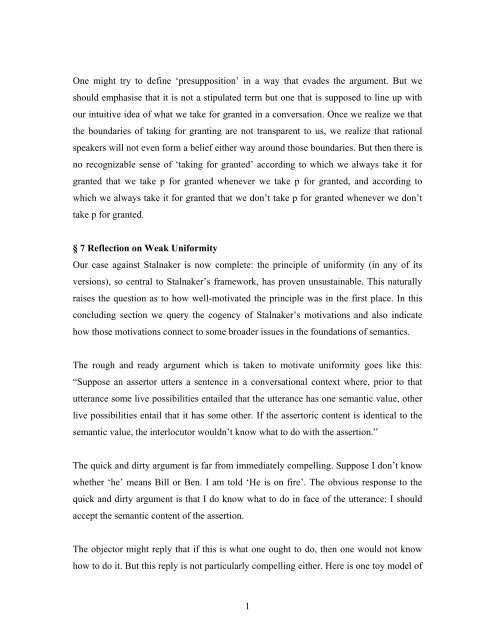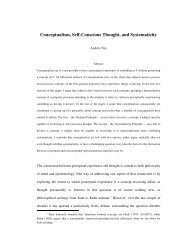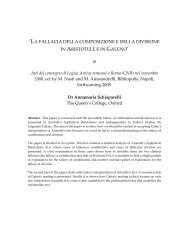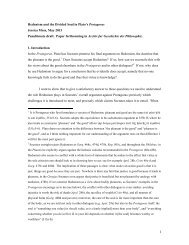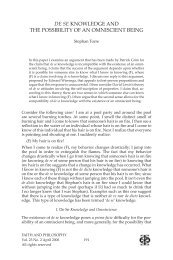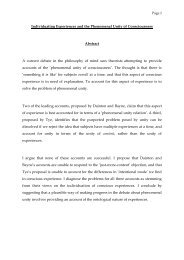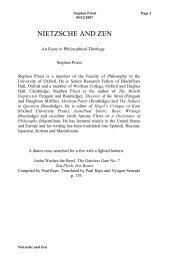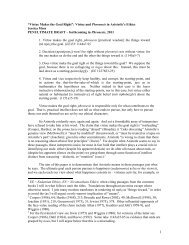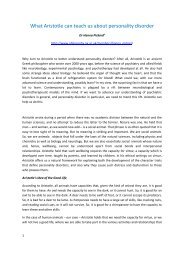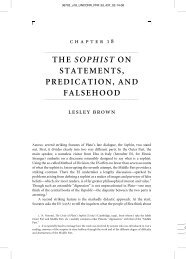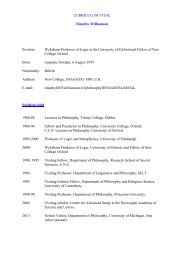In 'Assertion', Robert Stalnaker distinguishes between the sema
In 'Assertion', Robert Stalnaker distinguishes between the sema
In 'Assertion', Robert Stalnaker distinguishes between the sema
Create successful ePaper yourself
Turn your PDF publications into a flip-book with our unique Google optimized e-Paper software.
One might try to define ‘presupposition’ in a way that evades <strong>the</strong> argument. But we<br />
should emphasise that it is not a stipulated term but one that is supposed to line up with<br />
our intuitive idea of what we take for granted in a conversation. Once we realize we that<br />
<strong>the</strong> boundaries of taking for granting are not transparent to us, we realize that rational<br />
speakers will not even form a belief ei<strong>the</strong>r way around those boundaries. But <strong>the</strong>n <strong>the</strong>re is<br />
no recognizable sense of ‘taking for granted’ according to which we always take it for<br />
granted that we take p for granted whenever we take p for granted, and according to<br />
which we always take it for granted that we don’t take p for granted whenever we don’t<br />
take p for granted.<br />
§ 7 Reflection on Weak Uniformity<br />
Our case against <strong>Stalnaker</strong> is now complete: <strong>the</strong> principle of uniformity (in any of its<br />
versions), so central to <strong>Stalnaker</strong>’s framework, has proven unsustainable. This naturally<br />
raises <strong>the</strong> question as to how well-motivated <strong>the</strong> principle was in <strong>the</strong> first place. <strong>In</strong> this<br />
concluding section we query <strong>the</strong> cogency of <strong>Stalnaker</strong>’s motivations and also indicate<br />
how those motivations connect to some broader issues in <strong>the</strong> foundations of <strong>sema</strong>ntics.<br />
The rough and ready argument which is taken to motivate uniformity goes like this:<br />
“Suppose an assertor utters a sentence in a conversational context where, prior to that<br />
utterance some live possibilities entailed that <strong>the</strong> utterance has one <strong>sema</strong>ntic value, o<strong>the</strong>r<br />
live possibilities entail that it has some o<strong>the</strong>r. If <strong>the</strong> assertoric content is identical to <strong>the</strong><br />
<strong>sema</strong>ntic value, <strong>the</strong> interlocutor wouldn’t know what to do with <strong>the</strong> assertion.”<br />
The quick and dirty argument is far from immediately compelling. Suppose I don’t know<br />
whe<strong>the</strong>r ‘he’ means Bill or Ben. I am told ‘He is on fire’. The obvious response to <strong>the</strong><br />
quick and dirty argument is that I do know what to do in face of <strong>the</strong> utterance: I should<br />
accept <strong>the</strong> <strong>sema</strong>ntic content of <strong>the</strong> assertion.<br />
The objector might reply that if this is what one ought to do, <strong>the</strong>n one would not know<br />
how to do it. But this reply is not particularly compelling ei<strong>the</strong>r. Here is one toy model of<br />
1


